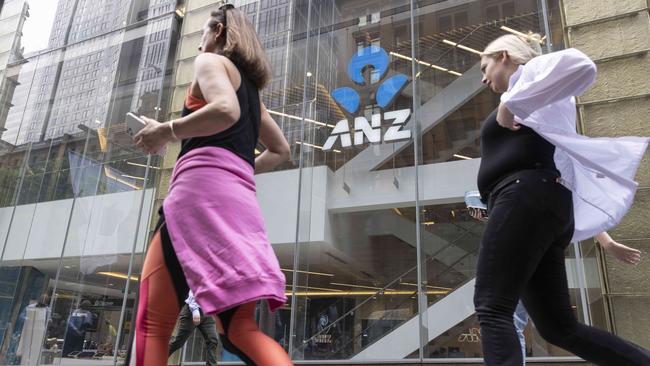ANZ Bank warns on inflation shocks, rapid rate hikes as cash profit jumps to $6.5bn
The banking major has warned on the economic outlook as consumers and businesses grapple with surging costs.
Business
Don't miss out on the headlines from Business. Followed categories will be added to My News.
ANZ has warned on the twin risks of inflation shocks and central banks pushing rates too high as the economy enters a challenging six months, with consumer confidence under threat and businesses grappling with rising energy costs.
In an interview with The Australian, chief executive Shayne Elliott said there was no easy path for policymakers, as he cautioned that some businesses would struggle to pass on price rises.
“The sad reality is that governments around the world and central banks are really struggling on inflation and it continues to surprise and so it makes policy settings and decisions really difficult,” Mr Elliott said.
“It eats away at consumer confidence because people get scared, and so it’s not great when we have these shocks because it undermines confidence about the future and it has an impact on the way people behave.”
Mr Elliott’s comments came a day after shock consumer price index data showed inflation accelerated from 6.1 per cent in June to 7.3 per cent over the year to September, driven in part by an 11 per cent quarterly jump in gas prices.
The hotter-than-expected inflation number has some, including Wesptac’s chief economist Bill Evans, tipping a double rate hike on Melbourne Cup day next week, in a move that could see the Reserve Bank take the cash rate to 3.1 per cent. Expectations remain for the central bank to lift rates by 0.25 per cent to 2.85 per cent.
Economists at all the major banks, including ANZ, increased their terminal rate expectations following Wednesday’s inflation data: CBA now expects the cash rate to peak at 3.1 per cent, while NAB is tipping 3.6 per cent, and both ANZ and Westpac see a peak of 3.85 per cent.

At the higher end of these forecasts, borrowers with home loans of $500,000 will be shelling out an additional $1058 per month compared to what they were paying before the first hike in May. Borrowers with loans of $1m will be paying an extra $2119 on top of their repayments before the first rate rise, according to RateCity.
Higher energy prices, meanwhile, were a further headwind for both retail and business customers, Mr Elliott warned.
“If you’re a cafe owner or something similar, electricity is going to be a reasonable input cost. The real question is do these businesses have the ability to pass on price increases or not? Some will and some won’t.
“For homeowners, there’s nothing to be passed on, it’s a question of having to absorb it. And there the question is, do you have the financial strength? Either because you’re getting paid more, hopefully, or because you’ve got savings or you’ve got other adjustments you can make in your expenditure to absorb those pretty hefty increases.”
Consumer confidence is already headed toward historic lows, sitting below 84 points, according to Westpac’s latest survey. This is far below the 100-point threshold where the number of optimists equal the number of pessimists.
Despite the pressures facing consumers and business, Mr Elliott remained confident in the outlook for ANZ, with higher rates delivering a boost to margins, at least in the near term.
The bank expected a “supportive environment” for margins in the first half, but cautioned that any change from the exit margin – at 1.8 per cent in September – was likely to be relatively more modest.
“The Reserve Bank’s reaction to manage (inflation) will be to increase interest rates. That is generally very positive for banks in terms of margin outcomes. And it’s generally okay in terms of volume because the economy is nominally growing and that needs to be financed,” Mr Elliott said.
“The question is, where does the damage come to the economy and banks in terms of credit losses? The concern is central banks will raise rates too much and tip the economy into recession unintentionally.”
Even in an “extraordinary downside” scenario that would see house prices falling 30 per cent, Mr Elliott said ANZ’s modelling suggested its customers were mostly robust, with higher offset and deposit balances than pre-Covid.
In its downside scenario, where house prices drop near 30 per cent, ANZ sees the unemployment rate hitting 6.4 per cent. In its severe downside scenario, house prices crumble 40 per cent and unemployment climbs to 10.8 per cent.
So far, stress spots are few and far between for the bank.

“It’s worth noting that 13 per cent of Australian postcodes have already experienced average house prices falls of more than 10 per cent. Our total exposure in those postcodes to those currently in negative equity is around 0.4 per cent of our book, or $780m.”
Mr Elliott downplayed the risks to lenders of any negative financial event, warning that most of the risks in the system would be found elsewhere, including in the struggling buy now, pay later sector.
“A lot of the risks that we’re seeing in the system, and I’m talking globally, aren’t sitting in bank balance sheets, they’re sitting somewhere else.
“Now there is risk in the system, you’re seeing risk sitting in buy now, pay later providers or non-bank financials or other leveraged parts of the financial system but not directly sitting in the banks,” he said.
Mr Elliott spoke after handing down ANZ’s full-year accounts, which showed cash profit climbed 5 per cent to $6.5bn over the 12 months through September 30.
Aggressive rate rises by the Reserve Bank shone through in the bank’s net interest margin, which jumped to 1.68 per cent in the second half, from 1.58 per cent over the six months through March.
The lift in profit was underpinned by momentum in its retail division, with second-half profit up 6 per cent, as well as institutional, which saw revenue jump 10 per cent half-on-half, driven by customer demand and disciplined margin management.
Despite the result, ANZ’s share price spent the day in the red, finishing the session down 3.3 per cent at $24.99.
Argo Investments chief Jason Beddow said the result was solid, with the share price reaction coming after a 20 per cent jump in the stock since July. “The numbers today were fine. The NIM came through as people thought it would, cost pressures were probably higher than people expected but still shouldn’t be a huge surprise given inflation,” Mr Beddow told The Australian.
“The way the market is at the moment, there’s plenty of rotation. If you’ve played the bank trade, it’s been a pretty good three months and maybe people are just taking a bit of profit.”
A long-awaited turnaround in its mortgage unit also came through toward the end of the second half, with ANZ saying it was now growing home loans in line with the rest of the market.
ANZ declared a final dividend of 74c a share, bringing the full-year payout to $1.46 per share, up from $1.42.
Jarden chief economist Carlos Cacho said the result was a solid beat, with cash profit, margins and dividend all beating expectations. “ANZ appears to have succeeded in turning around mortgage momentum, albeit our tracking suggests this is partly due to aggressive pricing,” he said.
“The key focus for us from the result was the beat on NIM and, more importantly, the exit NIM for September 2022, which is tracking well ahead of the first-half 2023 expectations.”
Originally published as ANZ Bank warns on inflation shocks, rapid rate hikes as cash profit jumps to $6.5bn





